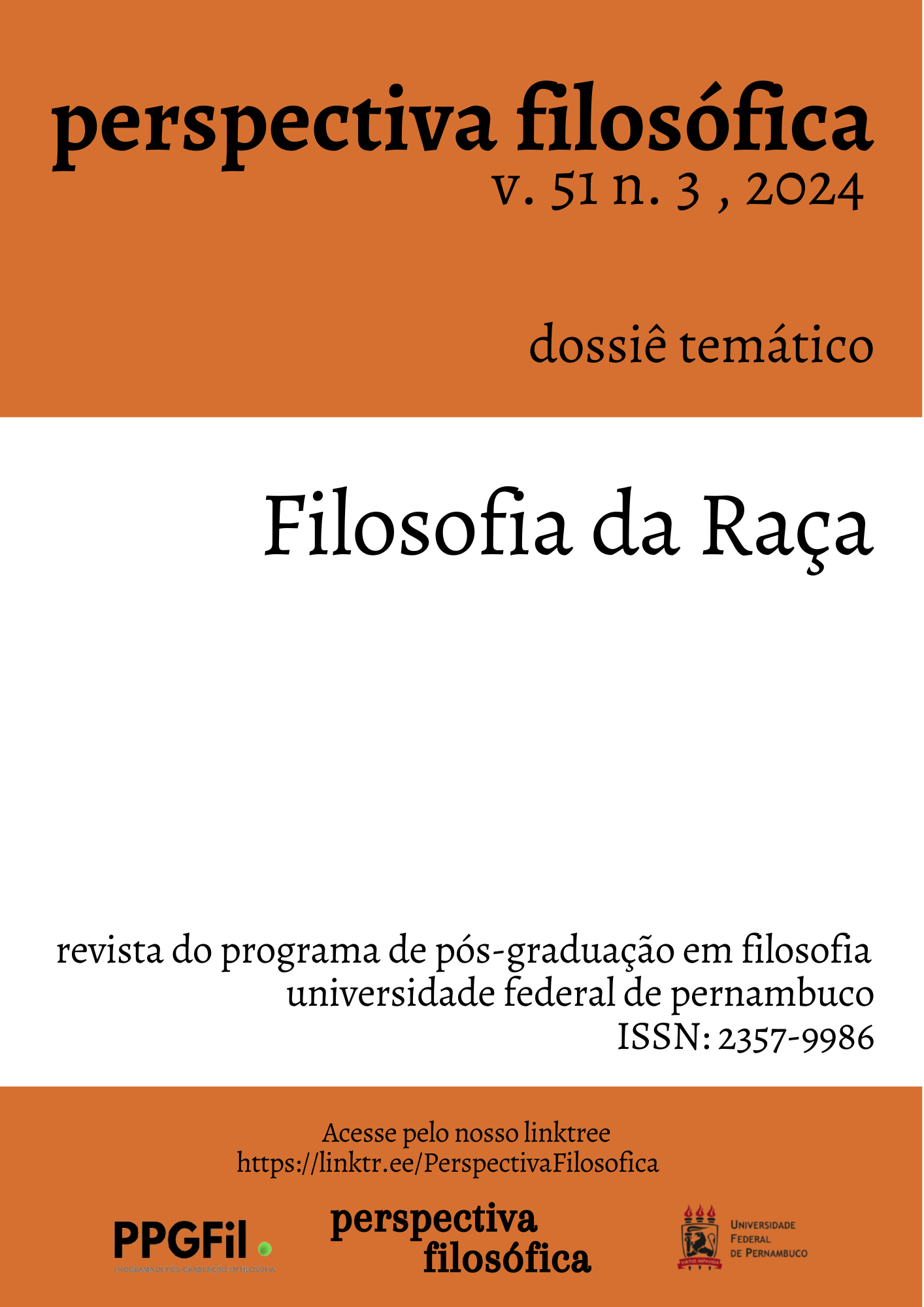The racially biased structure of the spatial perception of whiteness
DOI:
https://doi.org/10.51359/2357-9986.2024.263271Keywords:
implicit bias, de-suturing, habits, racial perception, spatial perceptionAbstract
During the last few decades, empirical research in social psychology has shown a significant influence of implicit bias in the way black people are perceived and categorized. It is still not clear, however, that the same methodology can be used to assess the presence of implicit biases in spatial perception. The purpose of this article will be to argue that the perception of space is indeed racially biased, though not in the sense assumed by much of empirical psychology. According to the present proposal, implicit biases will be understood as embodied perceptual habits. Such habits are shaped by racial categories and can take the form of what we call “white expansiveness”, in which space is perceived in terms of expansiveness and permissibility. This permissibility, however, is a mark of privilege rather than competence, constituting a racially biased perception of space. Confronting the implicit raciality of these spaces demands what philosopher George Yancy calls “de-suturing,” an affective and epistemic opening that exposes the illusion of spatial neutrality and reconceptualizes it as oppressive to the non-whites who occupy these same spaces.
References
AHMED, S. “A phenomenology of whiteness”. Feminist Theory v.8, n.2, 2007, p.149–167.
BARBOSA e SILVA, L. “Racismo Institucional e as Oportunidades Acadêmicas nas IFES.” Revista Brasileira de Ensino Superior, v.3 n.3, 2017, p. 80-99.
BEAUVOIR, S. O Segundo Sexo. Tradução: Sérgio Milliet. Rio de Janeiro: Nova Fronteira, 2009 (1949).
BOURDIEU, P. The Logic of Practice. Redwood City: Stanford University Press, 1980.
BROWNSTEIN, M.; MADVA, A. & GAWRONSKI, B. “What do implicit measures measure?” Wiley Interdisciplinary Reviews: Cognitive Science v.10, n.5, 2019, p. 1–13.
FAZIO, R.H.; SANBONMATSU, D.M.; POWELL, M,C. & KARDES, F.R. “On the Automatic Activation of Attitudes.” Journal of Personality and Social Psychology v.50, n.2, 1986, p. 229–238.
GAWRONSKI, B. & BODENHAUSEN, G. “The associative-propositional evaluation model: Theory, evidence, and open questions.” In: OLSON, J. M. & ZANNA, M. P. (orgs.), Advances in experimental social psychology. Cambridge: Academic Press, 2011, p. 59-127.
GREENWALD, A.G.; MCGHEE, D.E.; SCHWARTZ, J.L.K. “Measuring individual differences in implicit cognition: The implicit association test.” Journal of Personality and Social Psychology v.74, n.6, 1998, p. 464–1480.
HUGENBERG, K. & BODENHAUSEN, G. “Facing Prejudice: Implicit prejudice and the perception of facial threat.” Psychological Science v.14, n.6, 2003, p. 640–643.
HUGENBERG, K. & BODENHAUSEN, G. “Ambiguity in social categorization: The role of prejudice and facial affect in race categorization.” Psychological Science v.15, n.5, 2004, p 342–345.
JAMES, W. Principles of Psychology Vol. 1. New York: Dover Publications, 1950 (1890).
LEBOEUF, C. “The Embodied Biased Mind”. In: BEEGHLY, E. & MADVA, A. (orgs.). An Introduction to Implicit Bias: Knowledge, Justice, and the Social Mind (pp. 41–56). New York: Routledge, 2020, p. 41-56.
MACHERY, E. “Anomalies in implicit attitudes research.” Wiley Interdisciplinary Reviews: Cognitive Science v.13, n.1, 2022, p. 1–15.
MEDINA, J. The Epistemology of Resistance: gender and racial oppression, epistemic injustice, and resistant imaginations. Oxford: Oxford University Press, 2013.
MERLEAU-PONTY, M. Fenomenologia da Percepção. Tradução: Carlos Alberto Ribeiro de Moura. São Paulo: Martins Fontes, 2022 (1945).
MILLS, C. “Alternative Epistemologies.” In: MILLS, C. Blackness Visible: Essays on Philosophy and Race. Ithaca: Cornell University Press, 1998, p. 21-40.
MILLS, C. O Contrato Racial. Tradução: Teófilo Reis e Breno Santos. Rio de Janeiro: Zahar, 2022 (1997).
PAYNE, B.K; CHENG, C.M.; GOVORUN, O; STEWART, B.D. “An inkblot for attitudes: Affect misattribution as implicit measurement.” Journal of Personality and Social Psychology v.89, n.3, 2005, p. 277–293.
PAYNE, B.K. & GAWRONSKI, B. “A History of Implicit Social Cognition: Where Is It Coming From? Where Is It Now? Where Is It Going?” In: GAWRONSKI, B. & PAYNE, B.K. (orgs.). Handbook of Implicit Social Cognition. New York: Guilford Press, 2010, p. 19-37.
PRICE, J; WOLFERS, J. “Racial Discrimination Among NBA Referees.” The Quarterly Journal of Economics v.125, n.4, 2010, p. 1859-1887.
SÁ MOREIRA, F. “Estudos Filosóficos Sobre o Negro no Brasil: Um levantamento de teses e dissertações em temáticas negras nos programas de pós-graduação da área de filosofia (1987-2018).” Problemata v.10, n.2, 2019, p. 313-345.
SÁ MOREIRA, F. “Negros em Programas de Pós-Graduação em Filosofia no Brasil. Educação e Filosofia v. 37, n. 79, 2023, p. 429–454.
SANTOS, E.S; GOMES, N.L.; SILVA, G.M. & BARROS, R.C.S. “Racismo Institucional e Contratação de Docentes nas Universidades Federais Brasileiras.” Educação e Sociedade v. 42, 2021, e253647.
SULLIVAN, S. “Race, Space, and Place.” In: SULLIVAN, S. Revealing whiteness: the unconscious habits of racial privilege. Bloomington: Indiana University Press, 2006, p. 143-166.
WILSON, J.P.; HUGENBERG, K.; RULE, N.O. “Racial bias in judgments of physical size and formidability: From size to threat.” Journal of Personality and Social Psychology v.113, n.1, 2017, p.59–80.
YANCY, G. “Introduction: un-sutured.” In: YANCY, G. (org.), White self- criticality beyond anti-racism: how does it feel to be a white problem? Lanham: Lexington Books, 2015, p. xi-xxvii.
YOUNG, I.M. “Throwing like a girl: a phenomenology of feminine body comportment, motility, and spatiality.” In: YOUNG, I.M. On Female Body Experience. Oxford: Oxford University Press, 2005, p. 27-45.
Downloads
Published
Issue
Section
License
Copyright (c) 2024 Felipe Nogueira de Carvalho

This work is licensed under a Creative Commons Attribution 4.0 International License.
A Revista Perspectiva Filosófica orienta seus procedimentos de gestão de artigos conforme as diretrizes básicas formuladas pelo Conselho Nacional de Desenvolvimento Científico e Tecnológico (CNPq). http://www.cnpq.br/web/guest/diretrizesAutores que publicam nesta revista concordam com os seguintes termos:
Os autores mantém os direitos autorais e concedem à revista o direito de primeira publicação, sendo o trabalho simultaneamente licenciado sob https://creativecommons.org/licenses/by/4.0/deed.pt_BR que permite o compartilhamento do trabalho com reconhecimento da autoria e publicação inicial nesta revista.
Os autores têm autorização para assumir contratos adicionais separadamente, para distribuição não-exclusiva da versão do trabalho publicada nesta revista, com reconhecimento de autoria e publicação inicial nesta revista (Consultar http://opcit.eprints.org/oacitation-biblio.html).

Esta revista está licenciada com uma Licença Creative Commons Atribuição 4.0 Internacional.













